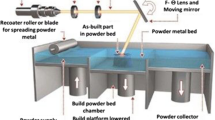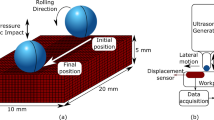Abstract
Understanding and anticipating the effects of surface roughness on subsurface stress in the design phase can help ensure that performance and life requirements are satisfied. One approach used to address this problem is to simulate contact between digitized real, machined surfaces, and then analyze the predicted subsurface stress field. Often, elastic-perfectly plastic contact models are used in these simulations because of their relative computational efficiency. Reported here is an analysis of the magnitude and location of maximum stress predicted using an elastic-perfectly plastic model. Trends are identified which then enable estimation of the upper bound of the simulation results based on surface discretization, operating conditions, and material properties. These estimations can be used as an effective and efficient tool for rapid prediction of maximum subsurface stress in real surface contact.












Similar content being viewed by others
References
Liu G., Wang Q., Lin C., (1999) Tribol. Trans. 42: 581
Mihailidis A., Bakolas V., Drivakos N., (2001) Wear 249: 546
Kadiric A., Sayles R.S., Zhou X.B., Ioannides E., (2003) J. Tribol. 125: 720
Palasantzas G., de Hosson J.Th.M. (2000) Acta Mater. 48: 3641
Gong Z.Q., Komvopoulos K. (2003) J. Tribol. 125: 16
Yu M.H., Bhushan B. (1996) Wear 200: 265
Tao Q., Lee H.P., Lim S.P. (2001) Wear 249: 539
Bailey D.M., Sayles R.S. (1991) J. Tribol. 113: 729
Lubrecht A.A., Ioannides E. (1991) J. Tribol. 113: 128
Liu S., Wang Q. (2001) J. Tribol. 123: 17
Lee S.C., Ren N. (1996) Tribol. Trans. 39: 67
Liu S., Wang Q., Liu G. (2000) Wear 243: 101
Polonsky I.A., Keer L.M. (1999) Wear 231: 206
Liu S., Wang Q. (2002) J. Tribol. 124: 36
Johnson K.L. (1985) Contact Mechanics. Cambridge University Press, Cambridge
Bhushan B. (1999) Principles and Applications of Tribology. Wiley, New York
Sayles R.S. (1996) Tribol. Int. 29: 639
Bucher F. (2006) Tribol. Int. 39: 387
Arnell R.D., Davies P.B., Halling J., Whomes T.L. (1991) Tribology Principles and Design Applications. Springer-Verlag, New York
Acknowledgments
The authors would like to express their sincere gratitude to the Eaton Corporation for providing surface digitization and to the US National Science Foundation IGERT Program, Office of Naval Research, and Department of Energy for research support.
Author information
Authors and Affiliations
Corresponding author
Rights and permissions
About this article
Cite this article
Martini, A., Escoffier, B., Wang, Q. et al. Prediction of subsurface stress in elastic perfectly plastic rough components. Tribol Lett 23, 243–251 (2006). https://doi.org/10.1007/s11249-006-9062-3
Received:
Accepted:
Published:
Issue Date:
DOI: https://doi.org/10.1007/s11249-006-9062-3




